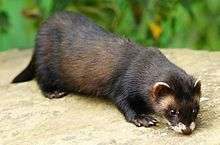Polecat-mink hybrid
| Polecat-mink hybrid | |
|---|---|
 | |
| European polecat (M. putorius) | |
 | |
| European mink (M. lutreola) | |
| Scientific classification | |
| Kingdom: | Animalia |
| Phylum: | Chordata |
| Class: | Mammalia |
| Order: | Carnivora |
| Family: | Mustelidae |
| Genus: | Mustela |
| Species: | M. putorius x M. lutreola |
A Polecat-Mink Hybrid, also known as khor'-tumak by furriers[1] and khonorik by fanciers,[2] is a hybrid between a European polecat and a European mink. Such hybridisation is very rare in the wild, and typically only occurs where European mink are declining.[3] The two species likely began hybridising during the early 20th century, when northern Europe underwent a warm climatic period which coincided with an expansion of the range of the polecat into the mink's habitat.[4]
Polecat-mink hybrids have a poorly defined facial mask, have yellow fur on the ears, grey-yellow underfur and long, dark brown guard hairs. They are fairly large, with males attaining the peak sizes known for European polecats (weighing 1,120-1,746 g and measuring 41-47 cm in length) and females being much larger than female European minks (weighing 742 g and measuring 37 cm in length).[3] The majority of polecat-mink hybrids have skulls bearing greater similarities to those of polecats than to minks.[5] Hybrids can swim well like minks and burrow for food like polecats. They are very difficult to tame and breed, as males are sterile, though females are fertile.[2][5] The first captive polecat-mink hybrid was produced in 1978 by Soviet zoologist Dr. Dmitry Ternovsky of Novosibirsk. Originally bred for their fur (which was more valuable than that of either parent species), the breeding of these hybrids declined as European mink populations decreased.[2] Studies on the behavioural ecology of free ranging polecat-mink hybrids in the upper reaches of the Lovat River indicate that hybrids will stray from aquatic habitats more readily than pure minks, and will tolerate both parent species entering their territories, though the hybrid's larger size (especially the male's) may deter intrusion. During the summer period, the diet of wild polecat-mink hybrids is more similar to that of the mink than to the polecat, as they feed predominantly on frogs. During the winter, their diet overlaps more with that of the polecat, and they eat a larger proportion of rodents than in the summer, although they still rely heavily on frogs and rarely scavenge off ungulate carcasses as the polecat does.[3]
See also
References
- ↑ Heptner, V. G.; Sludskii, A. A. (2002). Mammals of the Soviet Union. Vol. II, part 1b, Carnivores (Mustelidae and Procyonidae). Washington, D.C. : Smithsonian Institution Libraries and National Science Foundation. ISBN 90-04-08876-8.
- 1 2 3 "Khonorik: Hybrids between Mustelidae". Russian Ferret Society. Retrieved 9 May 2011.
- 1 2 3 Sidorovich, V. (2001) Finding on the ecology of hybrids between the European mink Mustela lutreola and polecat M. putorius at the Lovat upper reaches, NE Belarus Small Carnivore Conservation 24: 1-5
- ↑ Maran, T. and Henttonen, H. 1995. Why is the European mink, Mustela lutreola disappearing? - A review of the process and hypotheses. Annales Fennici Zoologici 32: 47-54.
- 1 2 Tumanov, Igor L. & Abramov, Alexei V. (2002) A study of the hybrids between the European Mink Mustela lutreola and the Polecat M. putorius Small Carnivore Conservation 27: 29-31